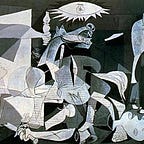Trump’s 6 Rules
- never allow the public to cool off;
- never admit a fault or wrong;
- never concede that there may be some good in your enemy;
- never leave room for alternatives;
- never accept blame;
- concentrate on one enemy at a time and blame him for everything that goes wrong.
While anyone can recognize Donald Trump’s standard operating procedure in these six rules, this observation of personality originated in a psychoanalytic report commissioned by the U.S. Office of Strategic Services (OSS) and submitted to the OSS in late 1943 or early 1944.
The report, titled “A psychological profile of Adolph Hitler,” was written Walter C. Langer, a Harvard trained psychoanalyst, in collaboration with other psychologists.
A few other quotes that struck me:
“Everything must be huge and befitting as a monument to the honor of Hitler.”
This reminded me of Trump’s “wall.”
“He conceives of himself as a second Christ who has been sent to institute in the world a new system of values based on brutality and violence.”
This also seems chillingly accurate given Trump’s glorification of violence toward his targeted adversaries.
“Many people have stopped and asked themselves: ‘Is this man sincere in his undertakings or is he a fraud?’”
Yes, is he a President or a reality TV star? And finally,
“He will go down in history as the most worshipped and the most despised man the world has ever known.”
It is this last quote, for me that draws my greatest attention. As Langer said of Hitler, many have “spontaneously adopted a religious attitude toward him.” Other’s loath him. I don’t loath Trump. However, I find him exceptionally dangerous to humanity, arriving as he has as the right type at the worst of all possible times.
Why are we fascinated by this “type?” What hold did Hitler have on the German people? What hold does Trump have on America and the world?
It seems we love him or we hate him. Is there something to this simple and polarized response?
He’s like the numbers in the elevator we can stare at as we go down. They are stupidly unnecessary, but at the same time so crucially necessary. With each number blinking into existence, a count down to our doom or salvation, our anticipation quickens.
We feel. And in a world of mind numbing over production of feeling, cutting through all that to “feel” something, anything, is feeling alive. And this feeling of aliveness seems to distract us, so necessarily, from our terrible and overwhelming fear as we hurl toward oblivion.
After the war, Langer wrote several book length psychological profiles of Hitler. However, for me, this document is the most interesting. Its purpose was to inform the U.S. military in the development of their wartime strategy.
In the document, Walter Langer successful predicted both the coup attempt against Hitler in 1944 and Hitler’s suicide. The entire document is available at the CIA library, and provides many insights into the psychological workings of a megalomaniac. The document was declassified in 1968.
